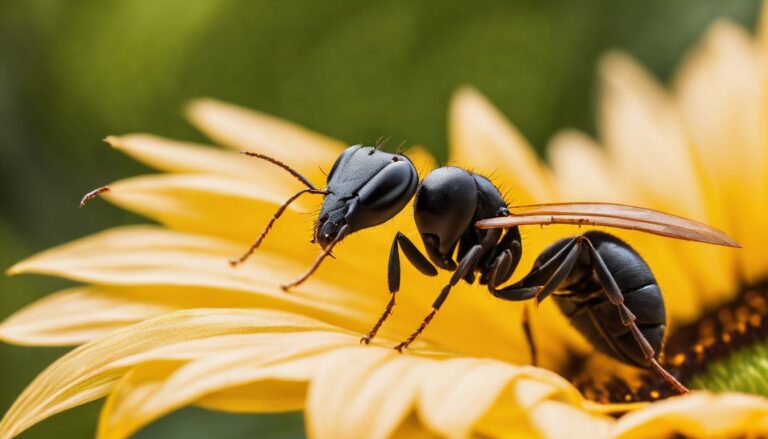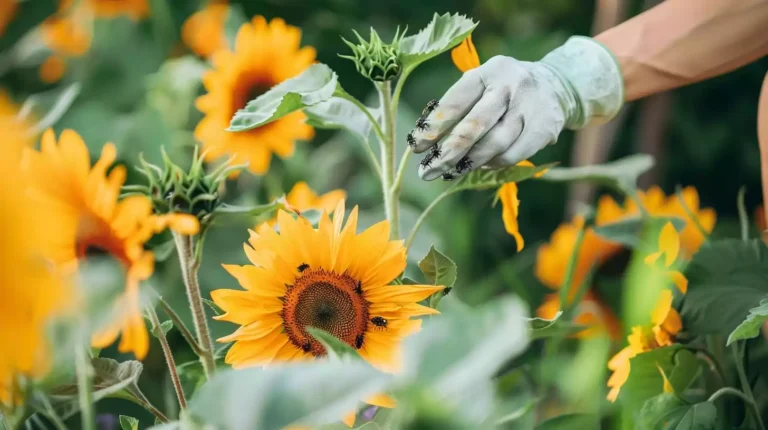Effective Methods For Eliminating Sunflower Maggots: A Step-by-step Guide
Sunflower maggots are pesky intruders that can severely damage your beloved sunflower plants. I know how aggravating this can be, as I’ve also grappled with these pests and taken the time to deeply study how best to eliminate them.
This article will provide you with a comprehensive step-by-step guide on how to get rid of sunflower maggots including organic pest control solutions, crop rotation strategies, and integrated pest management principles.
Stick around because it’s time we reclaim your beautiful sunflowers from those uninvited guests!
Key Takeaways
- Sunflower maggots can cause significant damage to sunflower plants, leading to wilting, stunted growth, and even death if left untreated.
- Effective methods for eliminating sunflower maggots include biological control (using beneficial insects and nematodes), chemical control (using insecticides and systemic treatments), and prevention strategies such as crop rotation and sanitation.
- Companion planting with herbs like marigolds, nasturtiums, basil, and garlic can help deter sunflower maggots naturally.
- Integrated pest management practices involving regular monitoring, promoting beneficial insects, practicing good sanitation, trapping methods, and using organic insecticides can further enhance maggot control while minimizing harm to the environment.
Identifying Sunflower Maggots
To identify sunflower maggots, look for signs of infestation such as wilting or yellowing leaves, stunted growth, and hollowed-out stems. The maggots themselves are small, creamy white in color, with a cylindrical body shape.
They feed on the roots and stems of sunflower plants, causing significant damage to the crop if left untreated.
Signs of infestation
You see holes in sunflower leaves. The plant is drooping or weak. There are slimy trails on the leaves and stems. These are signs of a maggot problem in your sunflower plants. Maggots make these signs when they eat plants and move around them.
It’s important to spot these marks early so you can stop the maggots before they do more harm to your flowers.
Physical Appearance Of Maggots
Sunflower maggots are small, white, legless larvae that resemble tiny worms. They have soft bodies and curved shapes, with a tapered head on one end. These maggots can vary in size depending on their stage of development, but they are generally about 1/4 inch long.
Their coloration may change as they grow older, turning from white to yellowish or even greenish. When fully matured, sunflower maggots will pupate and eventually emerge as adult flies or moths.
It’s important to be able to recognize the physical appearance of these pests in order to effectively identify and control them in your sunflower plants.
Damage Caused By Maggots
Maggots can cause significant damage to sunflower plants. These tiny larvae feed on the stems, leaves, and roots of the plant, leading to wilting, stunted growth, and even death in severe cases.
The feeding activity of maggots weakens the sunflower’s structural integrity, making it more prone to breakage and disease. Additionally, their burrowing behavior can disrupt nutrient uptake, causing further stress and hindering proper development.
It is essential to identify and eliminate these pests promptly to protect your sunflowers from extensive damage.
Effective Methods For Eliminating Sunflower Maggots
To effectively eliminate sunflower maggots, there are several methods that can be employed. These include biological control methods, chemical control methods, and prevention strategies.
Biological Control Methods
I use biological control methods to eliminate sunflower maggots. These methods are safe and natural. They help reduce the population of pests without harming the environment. Here are some effective biological control methods for eliminating sunflower maggots:
- Introduce beneficial insects like ladybugs and lacewings that feed on maggots.
- Use nematodes, tiny worms that attack and kill maggots in the soil.
- Apply microbial insecticides that contain bacteria or fungi to kill maggots.
Chemical Control Methods
Chemical control methods can be effective in eliminating sunflower maggots. Here are some options to consider:
- Insecticides: Using insecticides specifically formulated for sunflower pests can help kill maggots and prevent further infestation. Follow the instructions on the product label and apply the insecticide as recommended.
- Systemic treatments: Some insecticides can be applied to the soil or seed coatings, allowing them to be absorbed by the plant and reach pests like maggots that feed on it. This method provides long-lasting protection against sunflower pests.
- Contact sprays: Spraying an insecticide directly on the maggots can quickly kill them. Look for contact sprays that are safe for use on sunflowers and follow the application instructions carefully.
- Integrated pest management (IPM): Combining chemical control methods with other pest management strategies, such as biological controls and cultural practices, can enhance their effectiveness while reducing reliance on chemicals.
Prevention Strategies
Preventing sunflower maggots is important to protect your plants and maximize their growth. Here are some effective prevention strategies:
- Remove weeds regularly: Weeds can provide shelter and food for sunflower pests, so it’s crucial to keep your garden weed-free.
- Till the soil in the fall: This helps expose any overwintering pupae or larvae of sunflower pests, reducing their numbers in the next growing season.
- Rotate crops: Plant different types of crops in your garden each year to disrupt the life cycles of sunflower pests and reduce infestation risks.
- Practice good sanitation: Clean and maintain your planting area by removing debris, dead plants, and crop residues that can attract pests.
- Use resistant varieties: Choose sunflower varieties that are known to have natural resistance against common pests, including maggots.
- Implement companion planting: Some plants naturally repel pests. Consider planting marigolds or garlic near your sunflowers to deter maggots.
- Monitor regularly: Keep an eye out for signs of infestation, such as wilting or yellowing plants, and take action promptly if you spot any problems.
Crop Rotation And Sanitation
Crop rotation and sanitation play a crucial role in protecting sunflowers from maggot infestations. By rotating crops and keeping the planting area clean, you can disrupt the life cycle of maggots and prevent their reinfestation.
Learn more about these effective methods to eliminate sunflower maggots by reading on!
Importance Of Crop Rotation
Crop rotation is a very important practice in sunflower production. It involves planting different crops in the same area over time to help control pests and diseases. By rotating crops, we can disrupt the life cycle of pests and reduce their population.
This helps to maintain healthy soil and improve overall plant growth. Additionally, crop rotation can also help to prevent nutrient deficiencies and improve soil fertility. By changing the type of crop grown in an area, allows for more efficient use of nutrients and reduces the risk of depleting specific nutrients from the soil.
Overall, crop rotation plays a vital role in maintaining a sustainable and thriving sunflower production system.
Cleaning And Maintaining The Planting Area
Cleaning and maintaining the planting area is an important step in eliminating sunflower maggots. Here are some ways to do it:
- Remove weeds and other plant debris from the area.
- Clear away any dead or decaying plants that may attract maggots.
- Rake the soil to remove any hidden eggs or larvae of sunflower pests.
- Dispose of infected plants and debris properly to prevent further infestation.
- Keep the area clean and tidy to discourage pests from making it their habitat.
Removing Infected Plants And Debris
I always make sure to remove any plants that are infected with sunflower maggots.
- Inspect the sunflower plants for signs of infestation, such as wilting or discoloration.
- Carefully remove any infected plants from the garden.
- Place the infected plants in a sealed bag and dispose of them properly.
- Remove any fallen leaves or debris from the area around the sunflowers.
- Clean gardening tools and equipment to prevent spreading the maggots to other areas.
- Practice good sanitation by regularly removing weeds and keeping the garden area clean.
Companion Planting And Integrated Pest Management
Using companion plants can help to deter sunflower maggots and provide natural pest control. By planting strong-smelling herbs like mint, lavender, or rosemary near sunflowers, their scent can repel the maggots and discourage them from infesting the plants.
Additionally, implementing integrated pest management practices such as regularly monitoring pests, using traps or barriers, and promoting beneficial insects can further help manage sunflower maggot populations without relying solely on chemical control methods.
Using Companion Plants To Deter Maggots
Companion plants can help deter maggots and protect your sunflowers. Here are some options to consider:
- Planting marigolds next to your sunflowers can repel maggots with their strong odor.
- Nasturtiums are another good companion plant that helps deter maggots. Their pungent scent is disliked by many pests.
- Basil is not only a delicious herb but also a natural insect repellent. Planting basil near your sunflowers can help keep maggots away.
- Garlic is known for its strong smell, which pests find unpleasant. Planting garlic cloves around your sunflower garden can discourage maggot infestations.
Implementing IPM Practices
Implementing IPM practices can help to effectively manage sunflower maggot infestations. Here are some important steps to follow:
- Regularly monitor the sunflower plants for signs of pest damage or infestation.
- Use natural enemies, such as ladybugs or predatory insects, to control the population of sunflower maggots.
- Encourage biodiversity by planting a variety of flowers and crops in the surrounding area to attract beneficial insects.
- Practice proper sanitation by removing fallen leaves, plant debris, and weeds that can serve as breeding grounds for pests.
- Rotate crops regularly to disrupt the life cycle of sunflower maggots and reduce their numbers.
- Utilize trapping methods, such as sticky traps or pheromone traps, to catch and monitor adult moths or flies that lay eggs on the plants.
- Implement preventative measures, such as applying organic insecticides when necessary, to protect sunflowers from maggot infestations.
Questions and Answers
What Are Sunflower Maggots And How Do I Identify Them?
How Can I Get Rid Of Sunflower Maggots Using Effective Methods?
Can I Use Natural Methods To Control Sunflower Maggot Infestation?
How Long Does It Take To Eliminate Sunflower Maggots Using These Effective Methods?
Final Thoughts
In conclusion, this step-by-step guide provides effective methods for eliminating sunflower maggots.
By identifying the signs of infestation, implementing biological and chemical control methods, and practicing prevention strategies such as crop rotation and sanitation, you can successfully manage these pests.
With the use of companion planting and integrated pest management techniques, you can further protect your sunflower plants from maggot damage.
By following these steps, you’ll be well-equipped to maintain a healthy sunflower crop free from maggot infestations.






